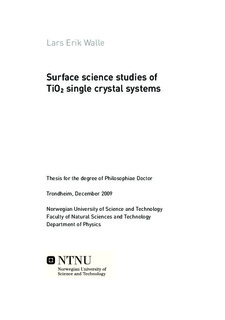| dc.contributor.author | Walle, Lars Erik | nb_NO |
| dc.date.accessioned | 2014-12-19T13:16:28Z | |
| dc.date.available | 2014-12-19T13:16:28Z | |
| dc.date.created | 2010-01-19 | nb_NO |
| dc.date.issued | 2009 | nb_NO |
| dc.identifier | 287785 | nb_NO |
| dc.identifier.isbn | 978-82-471-1887-0 (printed ver.) | nb_NO |
| dc.identifier.uri | http://hdl.handle.net/11250/246308 | |
| dc.description.abstract | Titanium dioxide is a material finding applications in variety of areas, including catalysis, photocatalysis, photovoltaics, energy storage, gas sensors and biocompatible materials. As a consequence, this material has been the target of numerous scientific studies over the last years. Due to its availability the rutile polymorph of TiO2 has become the benchmark surface for fundamental studies of metal oxide surface chemistry and the majority of experimental studies have been performed on this phase. The emergence of nanoscience has shifted the focus towards the anatase polymorph since this phase is preferred when forming TiO2 nanoparticles and applied systems almost exclusively comprise anatase TiO2 nanostructures. In this thesis synchrotron based high resolution photoelectron spectroscopy (PES) in combination with X-ray absorption spectroscopy (XAS) has been utilized to study how clean TiO2 single crystal surfaces interact with molecular and metallic adsorbates and formation of TiO2 films on a metal surface.
O 1s XAS in conjunction with PES was used to explore the conduction-band edge of single crystalline and nanostructured anatase TiO2. In the O 1s XAS process pure Ti d states cannot be probed due to selection rules. By appropriate energy referencing, the separation between the Ti d derived conduction-band edge and the threshold of the unoccupied Ti d-O p states was revealed. Also, 4% of an electronic charge per Ti ion was found to be sufficient to change the character of the empty states at threshold from pure Ti d to Ti d-O p, in good agreement with theoretical values.
By using highly surface sensitive PES, water adsorption on the rutile TiO2(110) and anatase TiO2(101) and (001) surfaces was investigated. For all three surfaces the formation of a water monolayer involving both associative and dissociative adsorption was demonstrated. Reducing the coverage by heating the monolayer resulted in an increased OH:H2O ratio. For the rutile TiO2(110) surface, without oxygen vacancies, neither OH nor H2O originating from the monolayer could be detected at room temperature, indicating that OH in the mixed monolayer is much less stable than OH formed at oxygen vacancies. The detailed nature of OH in the mixed layer was consistent with the notion of pseudo-dissociated water. For the anatase TiO2(001) surface dissociation occurred on the ridges of the (41) reconstruction, while a mixture of molecular and dissociated water was formed either in connection to the ridges or on the terraces. The exact composition of the monolayer on the anatase TiO2(101) was difficult to deduce due to simultaneous desorption of first and second layer water.
Submonolayer growth of Au on the anatase TiO2(101) surface resulted in two different Au particle types forming, one defect related minority type, which was only discerned up to an Au coverage of 0.14 ML. It appeared to be size-limited and had a constant relative CO uptake. A second particle type was first observed at 0.14 ML Au and continued to grow at higher Au coverages. It exhibited a decreasing relative CO uptake with increasing Au dose. The first particle type was attributed to oxidized gold, nucleating at oxygen adatoms on the terraces, while the second type was believed to be neutral gold particles growing at steps.
High resolution PES and XAS were used to study the formation of an ultrathin TiOx film on the Pt(110)-(12) reconstructed surface. A structural change from a rutile-like structure when TiOx coexisted with PtO2 to an anatase-like structure upon completion of the TiOx bilayer on the Pt surface was observed. A band bending of about 0.8 eV, induced by the PtO2 structures, was seen for the TiOx bilayer islands, an effect that disappeared upon completion of the bilayer. The full TiOx bilayer displayed a band gap 0.2 eV lower than that observed for bulk anatase | nb_NO |
| dc.language | eng | nb_NO |
| dc.publisher | Norges teknisk-naturvitenskapelige universitet, Fakultet for naturvitenskap og teknologi, Institutt for fysikk | nb_NO |
| dc.relation.ispartofseries | Doktoravhandlinger ved NTNU, 1503-8181; 2009:239 | nb_NO |
| dc.relation.haspart | Sandell, A.; Sanyal, B.; Walle, L. E.; Richter, J. H.; Plogmaker, S.; Karlsson, P. G.; Borg, A.; Uvdal, P.. Probing and modifying the empty-state threshold of anatase TiO(2). Physical Review B. Condensed Matter and Materials Physics. (ISSN 1098-0121). 78(7): 075113, 2008. <a href='http://dx.doi.org/10.1103/PhysRevB.78.075113'>10.1103/PhysRevB.78.075113</a>. | nb_NO |
| dc.relation.haspart | Blomquist, J.; Walle, L. E.; Uvdal, P.; Borg, A.; Sandell, A.. Water Dissociation on Single Crystalline Anatase TiO2(001) Studied by Photoelectron Spectroscopy. The Journal of Physical Chemistry C. (ISSN 1932-7447). 112(42): 16616-16621, 2008. <a href='http://dx.doi.org/10.1021/jp805664b'>10.1021/jp805664b</a>. | nb_NO |
| dc.relation.haspart | Walle, L. E.; Plogmaker, S.; Borg, A.; Sandell, A.. Growth of Au on Single Crystalline Anatase TiO 2 (101): Formation of oxidized gold. . | nb_NO |
| dc.title | Surface science studies of TiO2 single crystal systems | nb_NO |
| dc.type | Doctoral thesis | nb_NO |
| dc.contributor.department | Norges teknisk-naturvitenskapelige universitet, Fakultet for naturvitenskap og teknologi, Institutt for fysikk | nb_NO |
| dc.description.degree | PhD i fysikk | nb_NO |
| dc.description.degree | PhD in Physics | en_GB |

